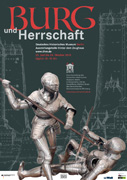


Castles and Power
An exhibition of the German Historical Museum
in cooperation with the exhibition „Mythos Burg“ (Myth of the Castle) of
the Germanisches Nationalmuseum in Nuremberg
Curators: Dr. Rainer Atzbach, Dr. Sven Lüken
To this very day castles remain the best known manifestations of the Middle Ages. The castle, no less so than the knight, the monk and the cathedral, has shaped our image of medieval times. Even the modern notion of the “citizen” endowed with “civil” liberties is derived from the notion of the “city” surrounded by the walls of the castle. Besides the famous picturesque ruins along the Rhine there are innumerable fortifications, moated castles and town castles between the Alps and the North Sea.
In fact castles served from the end of the Great Migrations to the advent of the Modern Age around 1500 as the centres of political and economic power and sites of administration and rule. Many of the lords of the castles formed alliances, thus consolidating their power to become sovereigns of the land – the Hohenstaufen, Hohenzollern, Hapsburg and Württemberg dynasties. The castle is more than a significant edifice, more than a fortress, more than a centre of administration.

To present this phenomenon in detail and show the most important developments of the castles is the aim of this exhibition of the German Historical Museum, which is being prepared concurrently and jointly with an exhibition of the Germanisches Nationalmuseum in Nuremberg on the topic of the “Myth of the Castle”.
Some 400 objects of various kinds will be brought together for the exhibition. Original architectural sections as well as models illustrate the different manifestations of medieval castles; documents, texts and pictures explain the significance of castles for the exercise of medieval rule; weapons and armour demonstrate their military role. Artworks and excavation findings reveal aspects of life in the castle in the great halls and court chambers, chapels and servants’ rooms. The wealth of stocks of the German Historical Museum will form the main fundament of the exhibition. Additional objects on loan from collections and institutions at home and abroad will further enrich the display.


